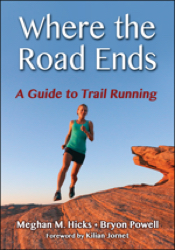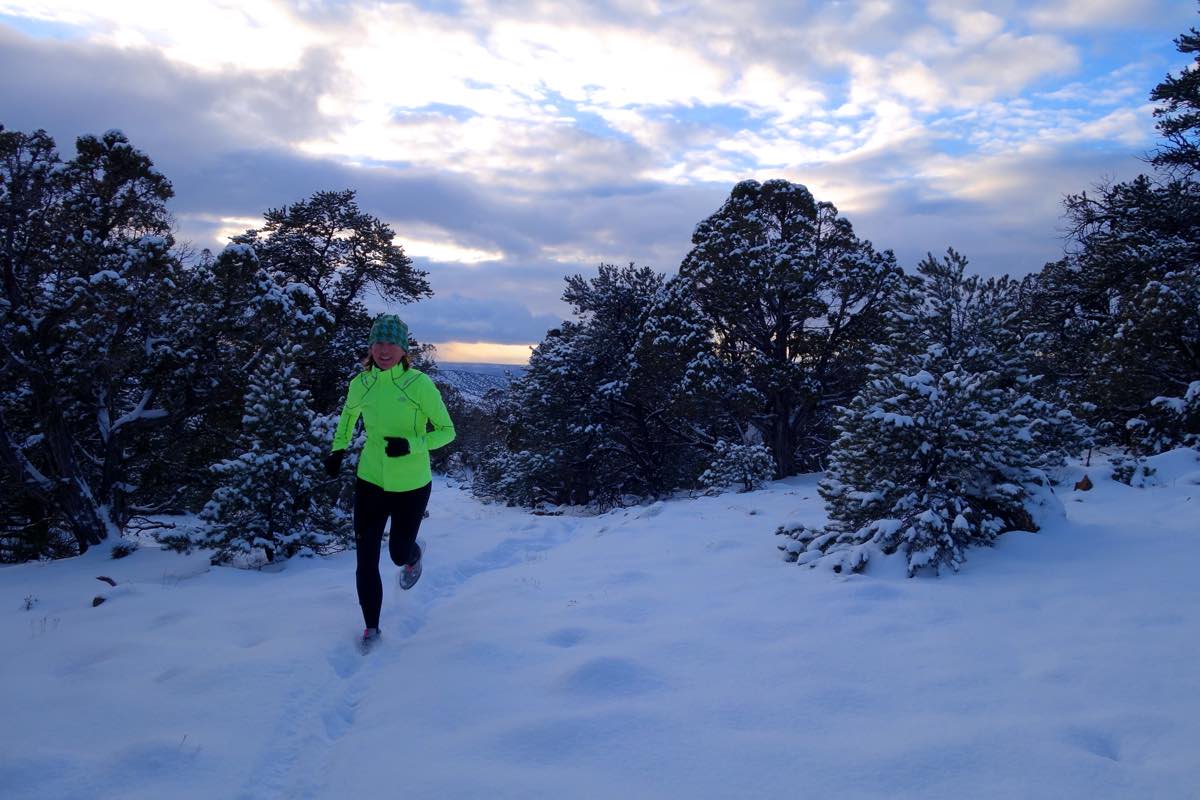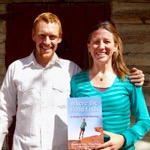
Like this article? Support iRunFar by purchasing our book “Where the Road Ends!”
Welcome to this month’s edition of “Where the Road Ends: A Guide to Trail Running!” That’s the name of both this column and the book Meghan Hicks and Bryon Powell of iRunFar published in 2016. The book Where the Road Ends: A Guide to Trail Running is a how-to guide for trail running. We worked with publisher Human Kinetics to develop a book offering the information anyone needs to get started, stay safe, and feel inspired with their trail running. The book Where the Road Ends teaches you how to negotiate technical trails, read a map, build your own training plan, understand the basics of what to drink and eat when you run, and so much more.
This column aims to do the same by publishing sections from the book as well as encouraging conversation in the comments section of each article. We want you to feel inspired and confident as you take on your first few trail runs as well as connected to iRunFar’s community of trail runners!
In last month’s and this month’s articles, we excerpt from Chapter 3 on how to negotiate the variable surfaces upon which we run. Last month, we talked about moving among hard-pack trails, soft-dirt trails, loose surfaces, and sand. This month, we learn about traveling among:
Sticks and Stones: Obstacle-Strewn Trails
Let’s discuss how to tackle trails with obstacles such as rocks and roots. The more obstacle filled the trail is, the more important it is to be aware, engaged, and in the active body position outlined in both Chapter 2 of the book as well as this article on iRunFar. You want to be able to go both over low objects and around taller ones
Low-Lying Obstacles
On trails with lots of low obstacles like roots and small stones, raise your feet a bit higher than normal. At the same time, be ready to step even higher as needed. Often, the best approach is to try to clear an obstacle in the middle of your stride, when your lead foot is naturally at its highest. To do this, you’ll likely have to adjust the length of your preceding couple of strides.
Sometimes, the best way to clear a low trail obstacle is to step on it. You may be able to add efficiency by carrying on in a straight line without altering your stride length or speed by turning an object like a stone into a stepping-stone. For obstacles likely to provide good traction on a stable surface, you can often land with most of your weight on the object. However, if the object might be either slippery or unstable, touch down on the object quickly and softly.
Weaving Between Obstacles
Higher obstacles or the desire for a more obstacle-free path might call for you to weave among the obstacles. If this is the case, you should be scanning the trail ahead, looking for the best route more than one obstacle in advance. If the trail surface isn’t slippery, you can weave about at will so long as you can find a spot to plant your feet. This running technique can be one of the great joys of trail running after you get the hang of it. If you’re looking to be most efficient, try to minimize sudden lateral movements and generally maintain a straighter course. Regardless of whether you take the playful or practical option, you’ll want to be up on your toes with the outsides of your legs feeling energized so that you’re ready for the next side-to-side movement.
If you’re aiming for efficiency, keep your torso laterally upright and moving forward down the trail in as straight a line as possible. Your feet and legs can be dancing off to your right and left while your center of gravity continues moving forward without pause or deviation.
Heads Up!
Finally, keep your eyes peeled for high obstacles like tree branches and rock overhangs that you’ll need to duck under or around to pass. Almost every longtime trail runner has a story about a painful brush with some sort of high obstacle. Although your attention might be focused on obstacles near your feet, use your peripheral vision and regularly glance up to scan the trail ahead for higher issues if you are in the forest or on closed-in terrain with rock exposure.
Getting Dirty: Muddy Trails
More than any mountain or forest, the image of a mud splash is probably most evocative of trail running. In some places, muddy trails are inevitable almost daily whereas they’re a rare occurrence elsewhere. Still, running on mud is a basic trail running skill that you should have in your arsenal.
[Editor’s Note: The ethics of running–or not running–in mud are discussed in the “Dirty Politics” sidebar in Chapter 3. We encourage you to read this to better understand how and when to avoid running on muddy trails to prevent trail damage and erosion.]
After a good, soaking rain, your trails might be covered in garden-variety mud. Anywhere from a fraction of an inch to an inch (up to 2.5 cm) of gloppy mud could cover the trail, and the ground as a whole will have more give than normal. Make sure to moderate your sudden adjustments when running on mud, whether you are moving laterally, braking, or accelerating.
Less mud can actually mean less traction. Such can be the case when you encounter a thin coating of mud on hard-packed dirt. That thin layer of mud is like grease on tile floor; it doesn’t take much to reduce traction to nothing. What’s more, even the luggiest rubber-soled shoes won’t bite into the ground because of the hard pack directly under the thin mud layer. You need to exercise a great deal of caution when traversing such sections. Don’t act quickly when changing direction or stopping. Pick up your cadence so that you can make additional and, therefore, smaller adjustments as needed. Try to contact the ground with light feet—just tapping and going. Add more of a vertical component to your footfall and more lift than normal.
Once in a while, you’ll encounter progress-stopping, shoe-sucking mud that grabs onto your feet and holds tight. The best advice for this type of mud? Avoid it. If you can’t avoid it, concentrate on landing with your whole foot simultaneously flat against the ground. As with running on sand, you do this primarily to increase flotation rather than to improve traction. Tread softly and quickly to minimize how far you sink in.
If you’re wearing lugged shoes, you might build up some mud in the tread. Even if the mud makes your shoes a bit heavier, taking the time to stop and clean off the mud is rarely worth it. That said, if the mud has clogged up your shoes’ lugs to the point that you’ve got comically bad traction (and an extra half pound per foot in mud weight), it might be time to clean the bulk of the mud out.
Rockin’ It: Rocky Trails
Rocks are trail running’s box of chocolates; you never know what you’re going to get. Some rocks are extremely grippy under all conditions. Others offer adequate traction when dry but might as well be banana peels in a comic book when wet. And some rocks never offer enough traction to be trusted.
The best advice for running on rocky surfaces—be it the endless slickrock outside Moab, Utah, a talus pathway over an alpine pass, or a trail in the Appalachian Mountains that’s got more rock than dirt for tread—is never to trust the rocks until you’ve tried them under similar conditions. The marble floor of a grand public building is a worry-free luxury on a sunny day. If you visit on a rainy day, however, the lobby is likely to be filled with freshly unfurled carpets and signs cautioning you to watch your step, because the marble is slippery when wet.
When running on rock or a trail that requires you to step on stones, minimize the risk of slipping by looking for places where the exposed rock is generally flat and aiming your footfalls there, if possible. That said, a little bit of surface variation can help with traction. If you have doubts about the grippiness of a rock, avoid landing on rock surfaces slanting in the direction that you’re traveling. Whether you strike with your forefoot or your whole foot is a matter of personal taste, but you should make quick, light steps with an increased cadence. Touch down and lift off right away.
Don’t let this talk of slipping keep you from running on rocky terrain! Rocky travel offers playful, adventurous, and challenging opportunities. Sometimes you’ll find that the rock over which you’re traveling offers incredible grip, better than any other trail surface. Using your increased traction to run up and down very steep pitches is amazing fun.
Hidden Obstacles
What can you do when grass, brush, dry leaves, or another obscurer prevents you from seeing the trail surface? Keep on running! But do so with caution, and possibly a bit slower. Remember the kinds of obstacles you’ve encountered in the preceding minutes and how frequently you encountered them. In addition, try to read the clues from the surrounding terrain. If a big tree of a species that tends to have large, exposed roots is growing right next to the trail, adjust your stride to account for these obstacles. Likewise, if you’re running below a cliff face that ends in a talus slope, prepare to encounter rocks.
If obstacles have been infrequent or low to the ground, you can slow your pace while lowering your stride to a “worm-burner” motion that feels more horizontal than vertical. This technique allows you to kick up against any low obstacles rather than land unpredictably atop an uneven or unstable one, possibly leading to a sprained ankle or fall.
Winter Wonderland: Wintry Trails
Winter trail running can be magical. It’s quieter. Fewer people are on the trails. The transformed landscape provides new challenges. Let’s see how you should tackle some of those challenges.
Let It Snow!
Oh, snow! As a trail runner, you’ll find that there are, in fact, countless kinds of snow and that each reacts differently under your feet. By its very nature, snow also obscures what lies below, thus adding complexity. Nevertheless, if you can learn just a few techniques, you can unlock a winter wonderland.
The biggest issues with shallow snow, from a trace to half a foot (15 cm), are the possibilities of slipping and of encountering obscured obstacles. Use a more vertical footfall and land more on your whole foot. Have your core engaged and your arms ready to react. On the other hand, if the snow only minimally hampers traction, go into obstacle-protection mode. In snow up to a couple inches, you should be able to pick up clues about the location of snow-covered obstacles and pick your way around them. As the snow gets thick enough to obscure small obstacles, try landing with a flat footfall to provide some extra flotation so that you sink slightly less deeply into the snow. This method will help keep you above the small deviations and obstacles that you can no longer see. Regardless, continue landing quickly and carefully while remaining mentally engaged so that you can react quickly should you land in a less-than-ideal spot. You should still be able to see larger rocks and roots so that you can maneuver appropriately.
Now, a foot (30 cm) of champagne powder? What is a gift to a skier can challenge the most adept trail runner. The light-as-air snow drifts with the wind and can easily obscure objects on the trail. It also compacts to next to nothing, such that a foot of snow can be less than an inch of snow after you’ve planted your foot on it. That means you can’t see obstacles, and the snow doesn’t do much to smooth out the underlying trail. This is a time to be cautious. If you know the trail and it’s free of larger obstacles, you can run with a more-or-less normal stride. When larger obstacles are more likely, slow your pace and shuffle your feet along the ground. Yes, you might kick the occasional rock, but that’s far better than unpredictably landing on one.
Snowshoes can open up trail running terrain in the winter. You can even trail run in them, as long as the trail is well packed or you’re on groomed snow such as a Nordic ski trail. (Check whether this is permitted on the trail you want to use first.) If you’ll be on virgin powder or crusty snow, snowshoes can get you out there, but there’s unlikely to be much running involved.
Ice Dancing
Wintry conditions also conjure images of slipping and falling. Ice can be found where snow has glazed over, where frozen rain has fallen, and where water has pooled and frozen. The inherent danger of running on ice should be obvious—it’s slippery as anything. You can easily end up on your butt by irreverently running on ice. However, with good technique, some confidence, and some practice, you can run reasonably safely on some ice.
As with any slippery situation, you want to minimize making sudden moves. This desire is greatly amplified on ice to the point that you want to eliminate rapid reactions. Aim for vertical footfalls, because any horizontal component to your footfall is likely to continue sliding outward. You’ll want to make quick, light contact with the ground under your body with a rapid rebound. Long, committed foot plants are an invitation to slip and fall. You can also quicken your cadence, which will not only help to shorten your stride but also put you in a rhythm that allows you to take the next step even more quickly should your foot start to slide. Keep your body in rapid-reaction mode so that you can quickly take another step, throw your arms out for balance, or prepare for an imminent fall. Obviously, slowing down can reduce your chances of slipping.
If you’re uncomfortable with running on ice or a particular stretch of it, don’t! It’s okay to walk, so err on the side of caution here.
Although most ice on the trail will be readily apparent, you may occasionally encounter “brown ice,” the trail equivalent to unseen “black ice” that you can come across on asphalt roads. Your best bets for spotting brown ice are to look for a glare or unexpected color change on the trail’s surface.
You can try a number of methods for improving traction in wintry conditions, from putting screws in the bottom of your shoes to wearing slip-on, over-shoe traction devices, which we’ll discuss in both the book’s Chapter 5, “Trail Tools,” as well as a later article here on iRunFar.
Excerpted from Where the Road Ends: A Guide to Trail Running, by Meghan Hicks and Bryon Powell. Human Kinetics © 2016.
Call for Comments
- What tips do you have for running amongst obstacles, through mud, on rocks, and in wintry conditions?
- What’s your best “oops” story where you tripped, fell, or otherwise stumbled around on some difficult terrain?
- Which of these surfaces is the most challenging kind of terrain for you?



